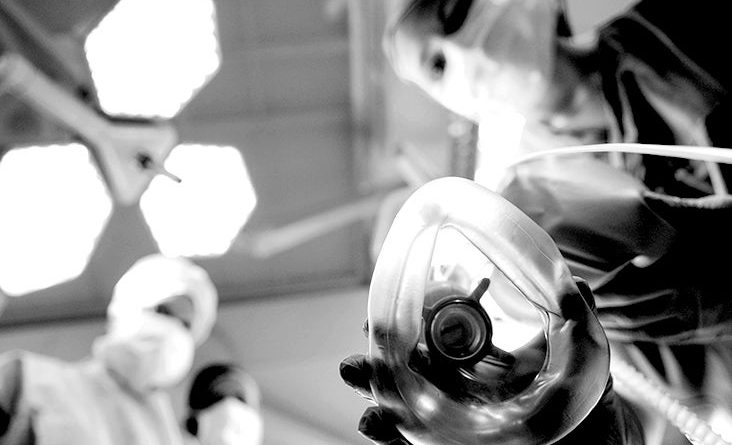Not all cataract surgeries require anesthesiologists, researchers say

- In a retrospective study of 36,652 cataract surgery patients, nearly 90% of the surgical procedures were performed in the presence of an anesthesiologist.
- The rate of complications within 7 days after cataract surgery was lower than that of other elective, low-risk, outpatient procedures, and researchers report the presence or absence of an anesthesiologist did not influence the complication rate.
- The study findings suggest an opportunity to use anesthesia care more selectively in people undergoing cataract surgery.
A cataract forms when the usually-clear lens inside the eye becomes cloudy. Cataracts usually develop slowly over years, causing a gradual blurring of vision.
When a cataract progresses to the point that it cannot be corrected with glasses and interferes with daily activities or lifestyle, then cataract surgery may be necessary.
The most common type of cataract surgery involves a technique called phacoemulsification. The surgeon makes a small incision in the outer layer of the eye and uses ultrasound to break up the lens, which is then flushed out using fine instruments and special fluids. A clear artificial lens made of a plastic-like material is then placed inside the eye.
Most cataract operations are performed under local anesthetic, in which the patient is awake but their eye is numb.
In the United States, where more than 2 million cataract surgeries are performed each year, it is considered standard-of-care (or “best practice”) for an anesthesiologist (or nurse anesthetist) to be present during the procedure to administer light anesthesia and to manage any unexpected complications.
However, the estimated rate of complications during cataract surgery is low – between 0.05% and 2.2%. This has raised questions about the need – or not – for anesthesiologists to be present during all cataract operations.
To shed more light on this issue, Dr. Dhivya Perumal and her colleagues investigated how often anesthesiologists were present during cataract surgery – and why – compared to other elective, low-risk, outpatient procedures. They also examined the rate of surgical complications in cataract surgery and other procedures.
Their findings were published in the journal JAMA Internal Medicine.
Key findings of the cataract surgery study
Between August 2020 and May 2021, Perumal and her coworkers analyzed data pertaining to Medicare beneficiaries who were 66 years or older and who underwent cataract surgery in 2017.
The main outcomes they assessed were:
- The prevalence of anesthesia care during cataract surgery compared with other low-risk procedures
- The association of anesthesia care with patient, clinician, and health system characteristics
- The proportion of patients experiencing a systemic complication within 7 days of cataract surgery compared with patients undergoing other low-risk procedures
Among 36,652 cataract surgery patients, the average age was about 74 years. Almost 60% of the participants were female while more than 87% were white.
The presence of an anesthesiologist was more common among people undergoing cataract surgery (nearly 90%) compared with people undergoing other low-risk procedures (range of <1% to 70%).
Patient characteristics such as older age and having multiple medical conditions are often given as reasons for the necessity of anesthesiologists during cataract surgery.
However, Perumal’s team reported that patient characteristics were not strongly related to the presence/absence of anesthesiologists during cataract surgery. Instead, they found that the most important influencing factor was the individual surgeon’s preference.
The researchers said that three-quarters (76%) of eye surgeons worked with an anesthesiologist in all of the cataract surgeries they performed. They found no link between the surgeon’s anesthesia approach and the occurrence of surgical complications.
Less than 8% of all cataract surgeries, with or without an anesthesiologist, resulted in complications within a week after surgery.
In contrast, 13% to 52% of people who underwent other low-risk procedures experienced complications.
Cataract surgeries without an anesthesiologist
This study revealed that about 10% to 12% of Medicare cataract surgery patients are already undergoing cataract surgery without the presence of an anesthesiologist and with no significant difference in complication rates.
These results are consistent with those of previous studies. Two separate studies, one with 13,500 patients and another with 4,347 patients, in which anesthesia was performed by nurses, found that cataract surgery had minimal complications and low adverse event rates regardless of the absence of anesthesiologists.
Together, researchers say, these findings suggest that some cataract surgeries can safely be performed without anesthesiologist involvement.
The lower rate of complications after cataract surgery compared with other low-risk procedures during which anesthesiologists were less commonly present “suggest an opportunity to use anesthesia care more selectively in patients undergoing cataract surgery,” the study authors concluded.
When the presence of an anesthesiologist is beneficial
In their paper, Perumal and her co-authors cautioned that “the current study does not offer sufficient justification for the complete removal of anesthesia-trained clinicians from the cataract surgery suite.”
Some cataract surgery patients, including those who require general anesthesia to undergo surgery, would benefit from intraoperative monitoring by an anesthesiologist, they said.
Dr. Gary Wörtz, an ophthalmologist specializing in cataract and refractive surgery, told Medical News Today that he advocates for using anesthetists during cataract surgery for various reasons.
“First, cataract surgery patients are generally over the age of 65 and frequently have a long medical history and daily medication list,” he said. “Secondly, cataract surgery is a procedure that even the most doctor-averse patients will eventually seek out if they get bad enough. […] So, we tend to get a rather large subset of patients who don’t otherwise take good care of themselves” and have undiagnosed cardiovascular problems.
Wörtz added that cataract surgery is “an incredibly delicate microsurgical procedure in which a person’s future vision is at stake.”
“I need to be fully focused on making precise movements and protecting the delicate tissues in the eye and not be distracted by the other medical issues,” he explained. “Complications typically arise from being distracted, and one way we limit distraction in the [operating room] is by having the anesthesia handled by an anesthetist. In the rare incident of an adverse reaction to a medication or respiratory depression, I want a team of experts surrounding me to make sure the patient is properly treated.”
Dr. David Fleischman, a clinical associate professor in the department of ophthalmology at University of North Carolina at Chapel Hill, expressed similar thoughts in his comments to Medical News Today.
“I have been surprised more than once by patients who became uncomfortable from positioning on their backs, claustrophobic, and so on. Anesthesia care was essential to restoring their comfort and helping complete their cases,” he explained.
“Remember that while cataract surgery is a successful, fast surgery, a complication can have lifelong devastating consequences for the patients,” he added.
Perumal and her co-authors noted that surgeons who perform other low-risk procedures might feel more comfortable managing sudden heart problems (a possible surgical complication) without the help of an anesthesiologist because they are more specialized in internal medicine compared to eye surgeons.
Some study limitations
This study had some limitations.
First, data was obtained from medical records and not by directly observing the cataract surgeries in a clinical trial.
Secondly, the researchers could not tell which specific type of anesthesia was used (monitored anesthesia care or general anesthesia).
Thirdly, they could not assess whether the presence of an anesthesiologist influenced how well the patients could see after surgery.
Finally, the rate of complications after cataract surgery may be overestimated since some complications may be unrelated to the surgery.
Source: Read Full Article



